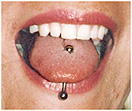News
Tongue piercing may cause gapped teeth
-
 Print
Print -
 Comments
(2)
Comments
(2)
-

A UB orthodontist has documented that “playing” with a pierced-tongue stud can eventually result in a gap between the front teeth.
-

Subjects frequently develop a habit of pushing the metal stud in their tongues up against and between the front teeth, creating a gap.
-

In many cases, patients did not have a space between their front teeth prior to the tongue piercing.
-

Thousands of dollars of orthodontic work may be required to close the gap, as was the case with this patient.
Mark this one down as a parental nightmare.
First, your child gets her tongue pierced. Then, as if you needed something else, she starts “playing” with the tiny barbell-shaped stud, pushing it against her upper front teeth. And before you know it, she forces a gap between those teeth—a fraction-of-an-inch gap that may cost thousands of dollars in orthodontic bills to straighten.
How and why this happens has been documented in a case study by UB researchers published in the July issue of the Journal of Clinical Orthodontics.
“It is a basic tenet of orthodontics that force, over time, moves teeth,” explains the study’s primary investigator, Sawsan Tabbaa, assistant professor of orthodontics in the School of Dental Medicine.
Tabbaa notes that a previous UB dental school survey study of Buffalo high school students revealed that the presence of a barbell implant/stud caused a damaging habit whereby subjects pushed the metal stud up against and between their upper front teeth, a habit commonly referred to among the students as “playing.”
“And it happened in very high percentage of the cases,” Tabbaa says.
That repeated “playing” with the stud may result in a gap, as is demonstrated in Tabbaa’s current case study.
The study involved a 26-year-old female patient examined in UB’s orthodontic clinic who complained that a large space had developed between her upper central incisors, or upper front teeth. The patient also had a tongue piercing that held a barbell-shaped tongue stud.
The tongue was pierced seven years earlier and every day for seven years the patient had pushed the stud between her upper front teeth, creating the space between them and, subsequently, habitually placing it in the space. She did not have a space between her upper front teeth prior to the tongue piercing.
“The barbell is never removed because the tongue is so vascular that leaving the stud out can result in healing of the opening in the tongue, says Tabbaa, “so it makes perfect sense that constant pushing of the stud against the teeth—every day with no break—will move them or drive them apart.”
The patient provided the research team with photos that demonstrated she had no diastema, or space, prior to having her tongue pierced. For the purposes of treating this patient’s space, it was assumed that positioning of the tongue stud between the maxillary central incisors, or “playing,” caused the midline space.
Her treatment involved a fixed braces appliance to push the front teeth back together.
Tongue piercing can result in serious injury—not just to teeth. It also has been associated with hemorrhage, infection, chipped and fractured teeth, trauma to the gums and, in the worst cases, brain abscess, says Tabbaa.
“The best way to protect your health, your teeth and your money is to avoid tongue piercing.”

Reader Comments
mary galuski says:
I don't know how credible this "research" is. It seems like the claims are based on old photos this girl had. I didn't get any new factual information from reading this.
Posted by mary galuski, student, 08/14/10
Mike Lisieski says:
The patient reported on here had her tongue pierced at age 19, and yet the introduction introduces this as problem as somethings parents should worry about their "children" doing. At 19, this patient was not a child, and without any further discussion of tongue piercing in children, the introductory paragraphs appear to exist only to imply that this woman (and other adults who choose to get piercings) should be treated like children.
There's also no mention of whether the orthodontics following the piercing complication were cosmetic or medical. The article is clearly trying to suggest that tongue piercings cause medically significant complications, but this is not supported by the case as presented.
Posted by Mike Lisieski, Student, 08/12/10